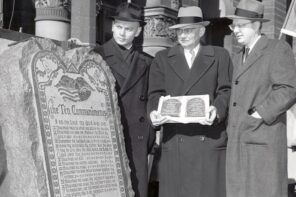Somewhere at Zondervan headquarters the supply room is looted and nobody has been able to steal pens. The publisher’s six-month, cross-country RV tour to create a completely handwritten edition of the NIV Bible concludes this month. America’s NIV, as the new edition has been dubbed, is being written by you and you and you.
A team from the publisher has been out on a ninety-city tour to collect a handwritten copy of every Bible verse. Expected to contribute are the ordinary and the extraordinary among us. Hopes are pinned on verses from president Obama and former president Bush.
The tour is a promotional-commemoration for Zondervan, a hybrid event that is part product launch, part self-congratulations. The publisher is cheering thirty years of exclusive publishing rights to the NIV translation, which it has used to tune the Bible to the people, that is, the people who need a Wild About Horses Bible or are New Women of Color in need of the Good Book.
Whether you are archeological, devotional, dramatic, or time-deprived Zondervan has you covered. When the newest member to this catalog is complete, the original, handwritten America’s NIV will be offered to the Smithsonian. Key in on the fact that it will be offered to the Smithsonian, a claim that makes no indication that the Smithsonian will care.
A reasonable question to Zondervan is seriously, what’s the point? Handwritten, or for that matter theme Bibles more generally, are nothing new. Gimmick scripture is a now genre both monotonous and shameless.
Moe Girkins is the president and CEO of Zondervan. In a press release she describes one purpose of America’s NIV as a “commitment to make the Word of God more accessible and more relevant to more people.” And yet an evaluation of her aim is flawed if we take Girkins at her word.
It is counter intuitive that anything is made more accessible by handwriting it rather than using type. Moreover the Bible may be America’s favorite book of all time, but its content is arguably the least read. This fact is pulled and punched by Stephen Prothero is his Religious Literacy: What Every American Needs To Know—But Doesn’t.
An irony Prothero observes leads to the fallacy that gimmick scripture makes God’s word accessible. As Bible learning was turned down, Prothero says, emotionalism was turned up in Christianity so if Girkins measures accessibility to the Bible by the number of hands that get excited, grab, and buy gimmick scripture, she is hitting the nail on the head. If Girkins is suggesting that by handwriting America’s NIV it will somehow increase the accessibility of the content, she’s kidding us all,
In full disclosure, I would know. I have authored gimmick scripture. I worked on the Revolve Bible, a Jesus-meets-Seventeen Magazine version of the New Testament. Sales of this Thomas Nelson Biblezine continue to demonstrate that Americans do indeed love to buy Bibles. A measurable corollary however does not exist between the ring of the cash register and religious literacy.
So skip over Girkin’s claim that Zondervan wants to make the Bible accessible through America’s NIV. Grab on instead to the self-important coattails of her newest piece of gimmick scripture. What it lacks in delivering religious literacy it makes up for in its method. Gimmick scripture is a perpetual witness—to you and you and you, no matter if you’re wild about horses, women of color, or both.




